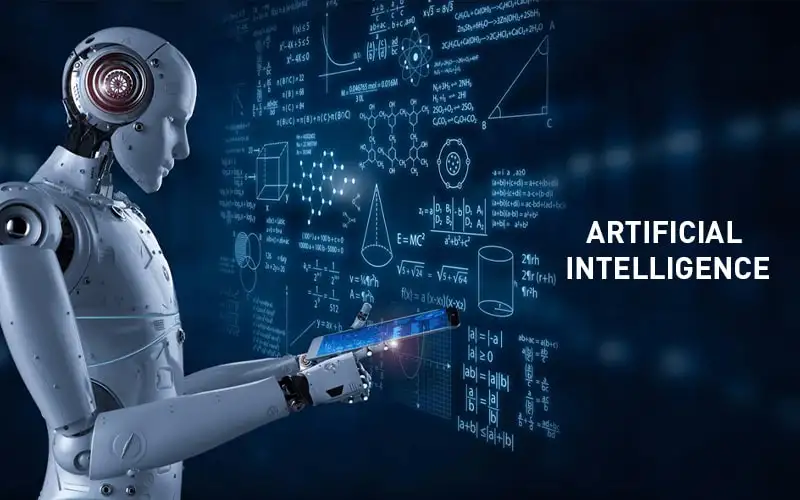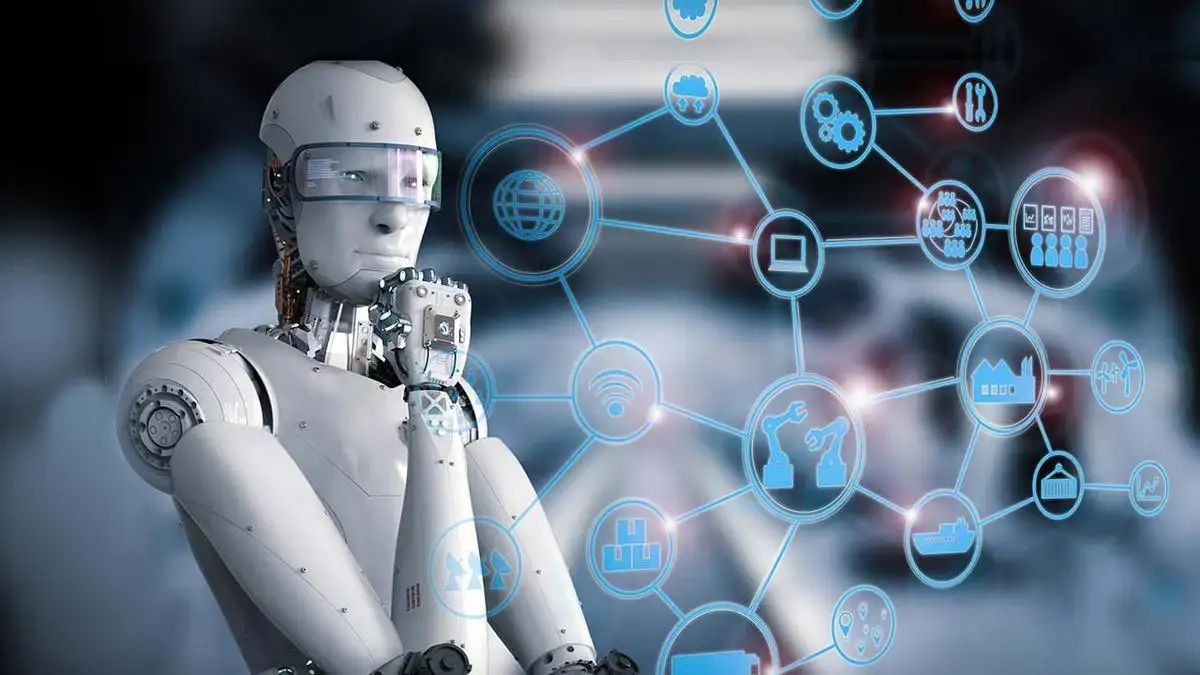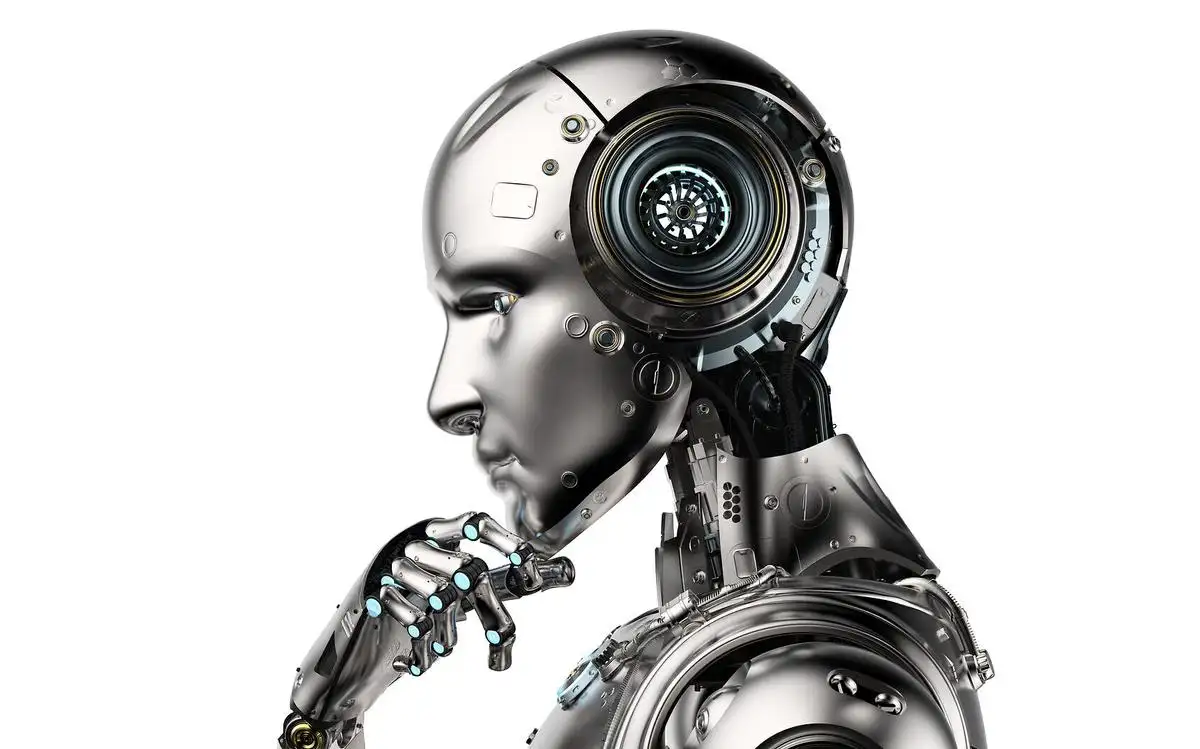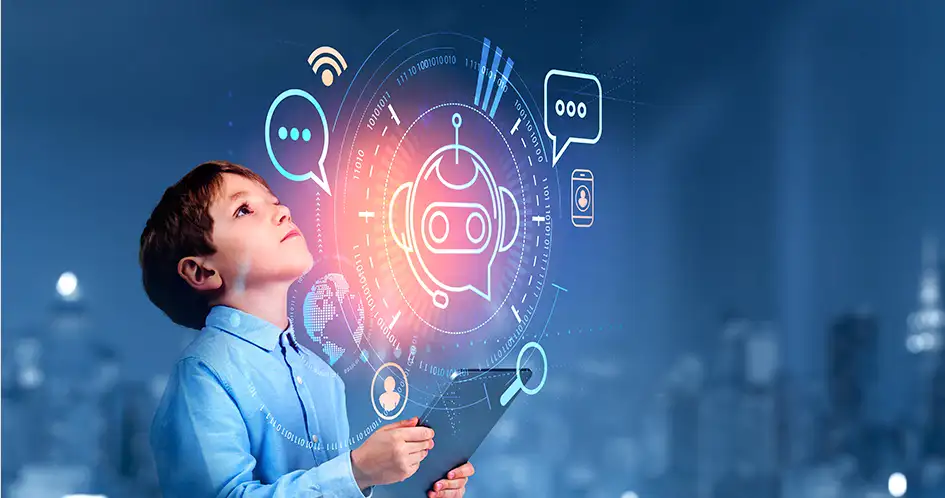
Artificial Intelligence?
Artificial intelligence is when machines, such as computers, simulate human intelligence processes. AI has specific uses in speech recognition, machine learning, expert systems, and natural language processing.

How does AI run?
As the buzz about AI rises, vendors are scrambling to emphasize how it is employed in their products and services. They frequently misinterpret technology as AI when it is only a part of it, like machine learning. AI requires a foundation of specialized hardware and software in order to develop and improve machine learning algorithms. Although Python, R, Java, C++, and Julia have become popular among AI developers, no one programming language can be said to be associated with AI.
For the most part, AI systems function by consuming enormous quantities of labeled training data, searching the data for correlations and patterns, and then utilizing these patterns to forecast future states. As a result of evaluating millions of instances, an image recognition tool may learn to recognize and describe things in photographs, much as a chatbot that is given examples of text can learn to produce lifelike dialogues with humans. Realistic writing, pictures, music, and other media may be produced using brand-new, quickly advancing generative AI approaches.
Cognitive abilities like the following are emphasized in AI programming:
- Learning. This area of artificial intelligence programming focuses on gathering data and developing rules on how to transform it into useful knowledge. The procedures, also known as algorithms, offer computer equipment detailed instructions on how to carry out a certain activity.
- Reasoning. The focus of this element of AI programming is on selecting the best algorithm to achieve the desired result.
- Self-correction. This feature of AI programming aims to improve algorithms over time and guarantee the highest degree of accuracy.
- Creativity. To create original pictures, texts, music, and ideas, this branch of AI makes use of neural networks, rules-based systems, statistical approaches, and other AI tools.
What is the significance of AI?
Because it has the ability to alter how we live, work, and play, AI is significant. It has been successfully employed in business to automate processes now carried out by people, such as lead creation, fraud detection, and quality control. AI is capable of doing jobs far more effectively than people in a variety of fields. AI technologies frequently do work fast and with relatively few mistakes, especially when it comes to repeated, detail-oriented activities, like analyzing a lot of legal papers to make sure key fields are filled in correctly. Artificial Intelligence may provide businesses with insights into their operations that they may not have known because of the enormous data sets it can analyze. In a variety of industries, the fast-growing population of generative AI tools will be crucial.
Indeed, improvements in AI methods have not only contributed to an explosion in productivity but also given some bigger businesses access to completely new economic options. Before the current wave of AI, it would not have been easy to imagine using software to connect customers with taxis, but Uber has done just that and expanded to become a Fortune 500 company.
The application of AI technology to enhance business processes and outperform rivals has become essential to many of today’s biggest and most prosperous organizations, like Alphabet, Apple, Microsoft, and Meta. For instance, AI is at the heart of Google, an Alphabet subsidiary, as well as Waymo’s self-driving cars and Google Brain, the company that created the transformer neural network design that is at the heart of recent advances in natural language processing.

Benefits and Harms of AI
Artificial neural networks and deep learning AI technologies are developing swiftly, mostly because AI can analyze massive volumes of data much quicker and produce predictions that are more accurate than humanly conceivable.
While the enormous amount of data generated every day would be overwhelming for a human researcher, AI programs that use machine learning can swiftly transform that data into useful knowledge. As of this writing, one of AI’s main drawbacks is how expensive it is to analyze the enormous amounts of data that AI programming demands. Organizations must be aware of AI’s potential to mistakenly or deliberately develop biased and discriminatory systems as it is implemented into more goods and services.
Benefits of AI.
The following are some advantages of Artificial intelligence.
- excellent at occupations requiring attention to detail. When it comes to melanoma and breast cancer diagnosis, AI has demonstrated that it can be just as good as physicians.
- faster completion of activities requiring plenty of data. To shorten the time it takes to analyze large data sets, AI is frequently utilized in data-intensive sectors like banking and securities, pharmaceuticals, and insurance. AI is frequently used in the financial sector, for instance, to assess loan applications and identify fraud.
- productivity is increased while labor is saved. Here, warehouse automation is used as an example. It increased during the pandemic and is anticipated to grow when AI and machine learning are integrated.
- provides reliable outcomes. Even tiny businesses can reach clients in their native languages thanks to the greatest AI translation solutions, which give high levels of consistency.
- may raise client happiness by being personalized. For specific users, AI may personalize webpages, messages, advertising, and content.
- There is always the availability of virtual agents driven by AI. Because AI programs don’t need to sleep or take breaks, they can work continuously.
Harms of AI.
The following are some disadvantages of AI.
- Expensive.
- needs someone with advanced technical skills.
- A scarcity of skilled personnel to create AI technologies.
- Scaled-down reflection of the training data’s biases.
- Inadequate generalization from one task to another.
- This creates more unemployed people by eliminating human occupations.

Powerful AI vs weak AI.
AI can be grouped as weak or strong.
- Weak AI. sometimes referred to as narrow AI, is created and educated to carry out a single task. Weak AI is used by industrial robots and digital assistants like Siri from Apple.
- Powerful AI. Programming that can mimic the cognitive functions of the human brain is referred to as strong AI, often referred to as artificial general intelligence (AGI). A powerful AI system may employ fuzzy logic to transfer information from one area to another and come up with a solution on its own when faced with an unexpected job. A powerful AI program should theoretically be able to defeat the Chinese Room defense as well as the Turing test.
What are the 4 types of artificial intelligence?
According to Arend Hintze, an assistant professor of integrative biology, computer science, and engineering at Michigan State University, there are four different types of artificial intelligence (AI). These range from task-specific intelligent systems, which are widely used today, to sentient systems, which do not yet exist. The groups fall under the following categories.
- Reactive machines. These artificial intelligence systems are purpose-built and lack memory. In the 1990s, Garry Kasparov was defeated by the IBM chess program Deep Blue. Deep Blue is capable of identifying pieces on a chessboard and making predictions, but since it lacks memory, it cannot draw on the lessons learned from the past to generate predictions about the future.
- Limited memory. These artificial intelligence (AI) systems have memories, so they may draw on the past to guide present actions. In self-driving automobiles, certain decision-making processes are constructed in this manner.
- Theory of mind. A psychological concept is called the theory of mind. It implies that AI would be socially intelligent enough to comprehend emotions. This kind of AI will have the capacity to extrapolate from human intents and forecast behavior, which is a requirement for AI systems to function as essential members of human teams.
- Self-awareness. The AI systems in this category are aware because they have a sense of who they are. Self-aware machines are aware of how they are right now. There is currently no such AI.
What examples of AI technology exist today?
AI is used in a variety of different technological applications. The following list of seven examples.
Automation.
Automation tools have the potential to increase the number and variety of jobs carried out when combined with AI technology. RPA is a type of software that automates routine, rule-based data processing tasks that are frequently completed by people. RPA can automate larger sections of business operations when used in conjunction with machine learning and other AI technologies, giving its tactical bots the ability to share information from AI and react to changes in procedure.
Machine learning.
This is the science of operating a computer without writing any code. Deep learning is a branch of machine learning that, to put it simply, is the automation of predictive analytics. A machine learning algorithm can be of three different types
Machine vision.
An automated system can now see thanks to this technology. Using a camera, digital signal processing, and analog-to-digital conversion, machine vision gathers and examines visual data. Machine vision is sometimes likened to human vision, however, it is not constrained by biology and may be designed to, for instance, see through walls. It is utilized in a variety of applications, including medical picture analysis and signature identification. Often confused with machine vision, computer vision focuses on automated image processing.
NLP (Natural Language Processing).
Here, a computer program is interpreting human words. Spam detection, which assesses an email’s trash status based on its subject line and body content, is one of the more established and well-known applications of NLP. Machine learning is the foundation for current NLP methods. Sentiment analysis, speech recognition, and text translation are all examples of NLP tasks.
Robotics.
Robotics design and production are the primary concerns of this technical discipline. Tasks that are challenging for humans to complete consistently or effectively are frequently performed by robots. Assembling lines for automobiles or NASA’s employment of robots to transport heavy goods into orbit are two examples. Researchers are also developing socially intelligent robots using machine learning.
Self-driving cars.
In order to develop automated driving abilities that allow them to stay in a specified lane and avoid unforeseen obstacles like pedestrians, autonomous cars use computer vision, image recognition, and deep learning.
Creation of text, images, and audio.
A wide variety of enterprises are using generative AI approaches to produce an apparently infinite variety of content kinds, from photorealistic paintings to email answers and scripts, all from text inputs.

Applications of Artificial Intelligence?
There are several different markets where artificial intelligence is used. Here are 11 instances.
AI in healthcare.
The two greatest wagers are on enhancing health outcomes and cutting expenses. Machine learning is being used by businesses to provide faster and more accurate medical diagnoses than people. IBM Watson is a well-known example of healthcare technology. It can answer queries posed to it and comprehends normal language. The system creates a hypothesis and then provides it with a confidence grading schema using patient data and other accessible data sources. Other AI applications involve deploying chatbots and virtual health assistants to aid patients and healthcare consumers in finding medical information, making appointments, comprehending the billing process, and carrying out other administrative tasks. A variety of AI technologies are also being utilized to anticipate, combat, and comprehend pandemics like COVID-19.
AI in education.
Grading may be automated by AI, freeing up time for other responsibilities for teachers. Students may be evaluated, and the system can adjust to meet their requirements, enabling them to work at their own speed. To help pupils remain on track, AI tutors might offer extra assistance. Additionally, technology may alter the settings and methods of instruction for kids, maybe even replacing certain professors. Generic AI may assist instructors in creating courses and other instructional materials and engage students in new ways, as shown by ChatGPT, Bard, and other sizable language models. With the introduction of these technologies, instructors are also forced to reconsider student assignments, tests, and regulations about plagiarism.
AI in finance.
Fintech companies are being disrupted by AI in personal finance software like Intuit Mint and TurboTax. These apps gather personal information and offer financial guidance. The home-buying process has been aided by other software, such as IBM Watson. Most Wall Street trading is now done by artificial intelligence algorithms.
AI in law.
Sifting through papers as part of the discovery process in law is frequently too much for human beings to handle. AI is speeding up and increasing customer service by helping to automate labor-intensive legal sector activities. Law companies utilize computer vision to categorize and extract information from documents, machine learning to characterize data and forecast results, and NLP to understand information requests.
AI in entertainment and media.
For targeted advertising, content recommendations, distribution, fraud detection, screenplay creation, and movie production, the entertainment industry employs AI technology. By streamlining media operations, automated journalism aids newsrooms in cutting time, expense, and complexity. AI is used in newsrooms to investigate stories, help with headlines, and automate repetitive activities like data input and proofreading. Uncertainty surrounds the viability of using ChatGPT and other forms of generative AI in journalism to produce content.
Human Intelligence vs Artificial intelligence
Some industry insiders feel that the word “artificial intelligence” is too intimately associated with popular culture, leading to the general public’s unrealistic expectations about how AI would alter the workplace and everyday life. In order to distinguish between autonomous AI systems—Hal 9000 and The Terminator are two examples from popular culture—and AI technologies that assist humans, they have proposed adopting the phrase “augmented intelligence.”
- Human intelligence. The term “augmented intelligence,” which has a more neutral meaning, has some academics and marketers hoping that it would help consumers understand that most AI deployments will be weak and just enhance goods and services. An illustration would be to automatically highlight crucial material in court filings or to automatically surface it in business intelligence reports. An industry-wide readiness to apply AI to enhance human decision-making is indicated by the quick uptake of ChatGPT and Bard.
- Artificial intelligence. True AI, or AGI, is strongly related to the idea of technological singularity, which is a future in which artificial superintelligence would govern and be considerably more intelligent than the human brain and will have the power to shape our world. Even while some developers are tackling the issue, this still falls under the category of science fiction. Many think that the development of AGI might be significantly aided by technologies like quantum computing and that the name AI should only be applied to this type of general intelligence.

History of Artificial Intelligence?
Since the beginning of time, people have believed that inanimate objects can possess intelligence. In stories, the Greek deity Hephaestus is seen making robot-like minions out of gold. Engineers created sculptures of gods that priests would animate in ancient Egypt. Aristotle, the 13th-century Spanish theologian Ramon Llull, René Descartes. Thomas Bayes also described human cognitive processes as being represented by symbols using the techniques and reasoning of the time. creating a foundation for artificial intelligence ideas like generic knowledge representation.
The groundwork for the development of the modern computer was created in the latter half of the 19th and early part of the 20th century. The first model of a programmable computer was created in 1836 by Cambridge University scientists Charles Babbage and Augusta Ada King, Countess of Lovelace.
1940.
The notion that a computer’s program and the data it processes may be stored in the computer’s memory was developed by Princeton mathematician John Von Neumann. The basis for neural networks was also set by Walter Pitts and Warren McCulloch.
1950.
Science has had the opportunity to test its theories regarding artificial intelligence thanks to the development of modern computers. Alan Turing, a British mathematician and World War II codebreaker developed one way for testing if a computer is intelligent. The Turing test measured a computer’s capacity to trick interrogators into thinking the answers to their queries were generated by humans.
1956.
A summer symposium held at Dartmouth College is frequently credited for launching the current science of artificial intelligence this year. The meeting, which was sponsored by the Defence Advanced Research Projects Agency (DARPA), was attended by ten notable figures in the area, including AI pioneers John McCarthy, Oliver Selfridge, and Marvin Minsky. Herbert A. Simon, an economist, political scientist, and cognitive psychologist, as well as computer scientist Allen Newell, were also there. The two demonstrated Logic Theorist, widely regarded as the first artificial intelligence (AI) program. Which was a ground-breaking computer program capable of proving certain mathematical theorems.
1950 to 1960.
Following the symposium at Dartmouth College, pioneers in the young area of AI claimed that a synthetic intelligence comparable to the human brain was imminent. Garnering significant government and commercial backing. In fact, important advancements in AI were made during the course of over 20 years of well-funded basic research. For instance, in the late 1950s, Newell and Simon published the General Problem Solver (GPS) algorithm, which could not solve complex problems but laid the groundwork for more advanced cognitive architectures. McCarthy also created Lisp, an AI programming language that is still in use today. Professor at MIT Joseph Weizenbaum developed ELIZA. A pioneering NLP program that served as the basis for modern chatbots, in the middle of the 1960s.
1970 to 1980.
The development of artificial general intelligence proved elusive, not imminent, and constrained by the problem’s complexity. As well as by restrictions on computer processing and memory. A barren period known as the first “AI Winter” lasted from 1974 to 1980 as a result of the government and businesses withdrawing their funding for AI development. A fresh surge of AI enthusiasm was created in the 1980s by research on deep learning techniques and the industry’s adoption of Edward Feigenbaum’s expert systems. But this enthusiasm was quickly snuffed out by another fall in government funding and corporate backing. Up to the mid-1990s, there was a second AI winter.
1990.
The late 1990s saw a rebirth in AI, which prepared the way for the astounding developments in AI we witness today. This renaissance was triggered by increases in computer capacity and an explosion of data. Big data and greater computing power enabled advancements in NLP, computer vision, robotics, machine learning, and deep learning. The first computer program to defeat a global chess champion was IBM’s Deep Blue, which achieved this feat against Russian grandmaster Garry Kasparov in 1997 as artificial intelligence (AI) development surged.
2000.
Additional advancements in NLP, voice recognition, computer vision, deep learning, machine learning, and speech recognition led to the development of goods and services that have influenced how we live today. These include the introduction of the Google search engine in 2000 and the launch of the Amazon recommendation engine in 2001. Facebook unveiled its facial recognition technology, Microsoft revealed its speech recognition system, and Netflix built its movie recommendation system. Google’s Waymo and IBM’s Watson initiatives both recently began operations.
2010.
An ongoing AI development stream occurred between 2010 and 2020. These include the introduction of Apple’s Siri and Amazon’s Alexa voice assistants. IBM Watson’s triumphs on Jeopardy, self-driving cars, the creation of the first generative adversarial network, and the introduction of TensorFlow. Google’s open-source deep learning framework, the founding of research lab OpenAI. Creators of the GPT-3 language model and Dall-E image generator, the defeat of world Go champion Lee Sedol by Google DeepMind’s AlphaGo
2020.
Generative AI, a category of artificial intelligence technology that can create original material, first appeared in the present decade. The first step in generative AI is prompt, which might be in the form of text, an image, a video, a design, musical notation, or any other input the AI system is capable of handling. In response to the query, several AI algorithms then return fresh information. Essays, problem-solving strategies, and lifelike fakes made from audio or visuals of a person are all examples of content. Language models like ChatGPT-3, Bard from Google, and Megatron-Turing NLG from Microsoft have amazed the world with their skills. but the technology is still in its infancy as seen by its propensity to give incorrect or distorted responses.

See More Artificial Intelligence





